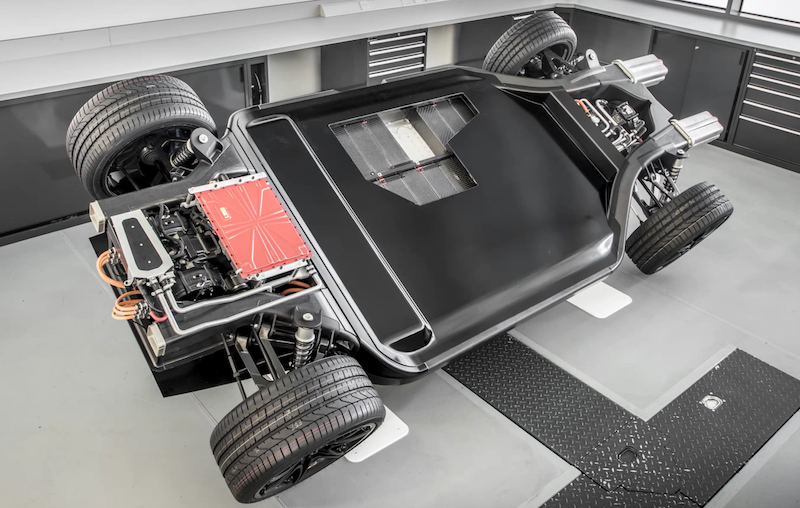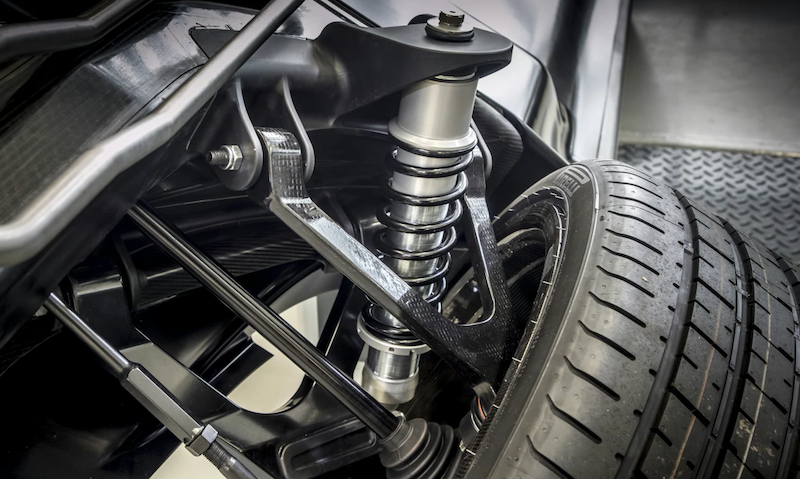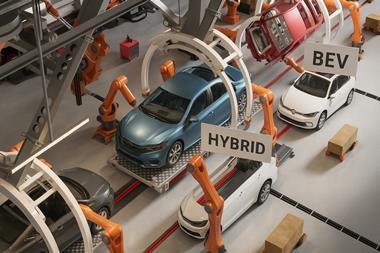Mike Farish visits Williams Advanced Engineering to see how the company delivers a distinctive F1 take on an innovative electric vehicle platform
 One of the implications of the growth of the market for electric vehicles is the opportunity it provides for newcomers possibly to become major players in the automotive industry at least as technology and sub-system suppliers to existing OEM operations. Sometimes such companies may be start-ups, sometimes they may already be well-known names in their own right.
One of the implications of the growth of the market for electric vehicles is the opportunity it provides for newcomers possibly to become major players in the automotive industry at least as technology and sub-system suppliers to existing OEM operations. Sometimes such companies may be start-ups, sometimes they may already be well-known names in their own right.
One company that fits the second of those descriptions is William Advanced Engineering based close to Oxford in the UK. The operation is the sister company of the Williams Formula One team and a major part of it remit is to develop commercial applications for techniques and technologies that find their initial use in the specialised world of F1 racing.
As such the two operations are not just colocated but closely integrated in the way they share a good deal of basic infrastructure – something confirmed by Paul McNamara, technical director for Williams Advanced Engineering. “We share the machine shop, composites manufacture, rapid prototyping equipment, wind tunnels and vehicle simulation – the two companies are operationally linked,” he states.
But, as McNamara further elaborates, the way the two operations interact is more complex than just that of technology transfer and resource-sharing. A further benefit is that it allows “partners”, effectively sponsors, of the race team to interact with the whole Williams Group “in a broader way” than is allowed by just a focus on the F1 vehicle, which he says with disarming frankness is otherwise essentially just a “marketing platform”. Another is that because the Advanced Engineering team works with a wide range of external sources of technical expertise – not least mainstream automotive OEMs – it naturally comes into contact with “materials, ideas and technologies” that it can pull in to assist the F1 operation in its necessarily tightly-focussed quest for sheer speed.
In itself, McNamara continues, this sort of activity is nothing new for Williams. “We have always had third party projects,” he states. “We had a Le Mans project with BMW in the early 2000s for instance.” But it was as recently as 2010 when the situation become formalised with the official founding of Williams Advanced Engineering to support its work with Jaguar in the intended production of the C-X75 hybrid-electric vehicle that was scheduled to start production in 2013. But that project was cancelled right at the end of the previous year which meant that as 2013 dawned the new operation was looking for projects that could enable it to continue its mission.

Triple expertiseOne of the most recent is a solo effort rather than a collaborative venture which was unveiled in the second half of last year. This is a highly innovative electric vehicle platform – essentially the motors, battery pack, chassis and wheels – that the company calls the FW-EVX. McNamara indicates that the genesis of the project came the year before last when the company decided that it had particular expertise in three areas - “energy storage, lightweighting and aerodynamics” - and asked itself how it could combine them into a distinctive “F1 take” on the design and construction of an electric vehicle platform.
The company’s familiarity with first of those, by the way, stems from more than just isolated projects like the C-X75. As McNamara points out Williams is now into its fourth year as the sole battery pack supplier for the Formula E electric racing car competition – a monopoly intended to ensure that all the competitors are precisely equal in terms of the basic power supply for their vehicles. The experience has, he states, “given us a lot of ideas about lightweight, high-performance batteries.” The other two factors, though obviously ones that any vehicle design and manufacturing operation would possess, are necessarily also ones that would be particularly acute when derived from F1 experience.
Moreover, the company is also already putting that experience to work in a real on-road vehicle development project. It is cooperating with Aston Martin in the development of the latter’s RapidE electric vehicle due for launch late next year.
Embodying the experienceThe FW-EVX initiative is far from being an experimental blue-sky venture. Instead it is, as McNamara stresses, aimed at embodying the experience in EV technologies Williams Advanced Engineering has gained over the past few years in a platform that could prove practicable for real vehicle development projects.
“We aimed for something that could go on the road and that would achieve good performance with off-the-shelf components within a standard size of vehicle,” he states. Indeed, he continues, it is quite specifically intended to be analogous in size to existing premium sector vehicles such as those in the Jaguar XE or Audi A4 series.
The concept therefore uses a 2800mm wheelbase to help provide for an energy capacity of 80kWh. As it has been developed the concept offers the options of rear wheel drive only or of full four-wheel drive. In the first of those configurations the concept has twin YASA motors and an Xtrac gearbox that allow for a power rating of 320kW. In the second these are supplemented by a further single 160kW motor to allow for a total power of 480kW. Total weight including battery cells would be 955kg.
But in addition, says McNamara, Williams aimed to use the FW-EVX to showcase three particularly innovatory approaches to meeting the challenges involved. Two of them involve the way materials are used and one the way the platform is constructed to facilitate efficient in- use performance.
The first of these is the use of carbon fibre to create a battery box that is not just a container but actually provides the whole assembly with structural strength. But, as McNamara further explains, in order to achieve this the company has pioneered an innovative fabrication technique for carbon fibre materials for which the FW-EVX is so far the only application. Essentially the technique that the company calls 223 as a shortform for 2D to 3D composite forming process involves the initial targeted curing of a flat sheet of the material so that the areas that will form the hinges when it is bent into shape are left uncured and therefore flexible.
This selective curing is affected by means of a press forming approach in which only the areas under the press are cured and is then followed after folding has taken place by a secondary curing process that ensures a consistent all-over strength for the part. The technique is, McNamara states confidently, unique to Williams. “It is our idea and we have patented it,” he confirms, adding that though some supporting materials development work has taken place it has “not required the formulation of anything super exotic”.
Assembly techniqueThe second also concerns the use of carbon fibre material in this case to manufacture the wishbones for the assembly using a technique Williams calls Racetrak. It involves using a robotic technique to lay unidirectional fibres made from recycled material within a mould tool and then pressing the assembly into the required final shape. When asked what Williams has used as its source of previously used material at this initial stage McNamara replies, perhaps unsurprisingly, “chopped up Formula One cars”.
The underlying objective of the technique itself, McNamara explains, is to demonstrate “reduction of cost” compared with other composite-based processes something achieved not just by the use of what might otherwise be scrap material but also by the fact that the in-press process time is just 90 seconds. Nevertheless, though final unit cost would still be more than for a current conventional steel or aluminium counterpart parts made this way would be 40 per cent lighter than one made from metal. Again the technique is unique to Williams and has been patented.
Meanwhile the third involves the way the actual geometry of the platform is used to facilitate enhanced performance specifically in the way airflow is managed to effect battery cooling. As McNamara explains, “the cooling system has been integrated within the platform in a way that dispenses with the need for a radiator at the front and that instead ducts the air through the sills and then exhausts it in the low-pressure area beneath the rear wheels.”
But, McNamara continues, the way the platform is constructed to affect this has also been exploited to serve another quite distinct purpose as well – that of impact resistance. It uses an extrusion structure along its sides both to conduct the air and provide side impact protection for the batteries and by implication passengers who might be sat above them. “This is a big issue for issue for electric vehicles,” he observes.
The whole concept, McNamara states, is aimed at integrating “light weight, energy storage and aerodynamics” - something epitomised by this clever use of structure. As he puts it in the FW-EVX what might in a conventional format be the quite distinct “radiator and energy absorption requirements” are solved together rather than separately.
 Wishbones are assembled using a technique Williams calls Racetrak
Wishbones are assembled using a technique Williams calls RacetrakNevertheless, there are still conventional heat exchange processes in order to ensure that motors, inverters and batteries are all kept at appropriate temperatures. For the motors and inverters a single process is involved with the thermal energy absorbed by a coolant mixture before it is transferred to the air flowing through the side ducts. For the batteries, which reach a much higher operating temperature, a two-stage process takes place before that final transfer to the airflow in the ducts with thermal energy first absorbed by an immediately adjacent refrigerant and then undergoing a further transfer cycle. Hence the engineering of the ducts down the side of the structure is even more purposeful and innovatory than it might seem at first glance since their internal partitioning, which has a surprising ‘wavy’ shape, supports both structural requirements and simultaneous heat exchange processes to dissipate thermal energy from two distinct sources.
One respect in which the FW-EVX project builds directly on previous experience, though, is in the battery management system which McNamara says is derived directly from Williams’ Formula E experience. Interestingly the design uses pouch-shaped lithium ion batteries rather than those with a cylindrical configuration. McNamara says that the reason is simply that in this instance that battery format was better suited to the space constraints involved though he also points out that batteries of this sort are already used by, for instance, the Nissan Leaf and Chevy Volt vehicles. In any case the design could be made to accommodate cylindrical batteries if need be.
But at the moment the FW-EVX is a long way from being an on-road reality. Though a few physical full-size prototype models exist McNamara says that the concept is still effectively an amalgam of “design, CAE and demonstrator”. It exists in the “virtual space” as far as is practicable at the moment though in the real world it has not yet actually moved under its own power. The next step, therefore, will be the construction of an “engineering demonstrator” for which Williams is now seeking development partners.
"Wishbone assembly involves a robotic technique to lay unidirectional fibres made from recycled material then pressing into the required final shape"
In fact, McNamara confirms, some spin-off projects with external partners involving further development of the 223, Racetrak and cooling concepts separately from each other are already underway. “We are discussing putting 223 and Racetrak into cars,” he confirms. As such, he says, the project “has already done its job” of getting Williams recognised as a company that can be a partner in ventures aimed at bringing low-volume, premium sector electric vehicles to the market. Nevertheless, beyond that the ambition certainly exists to initiate a comprehensive, integrated development project for the concept as a whole if a suitable partner shows willing.
But beyond even that a further vista opens up – that of Williams Advanced Engineering demonstrating the potential the burgeoning electric vehicle market holds out for companies that are currently just specialist technology development partners for more established mainstream automotive players to become major technology suppliers in their own right. Asked if he could see this being the case for Williams over a timescale of, say, the next ten years McNamara’s answer to is as concise as it is emphatic: “Yes, definitely.”
Indeed, discussions are already underway to establish a joint venture that will set Williams firmly on that path. “Williams are exploring entering into a joint venture with another company to create a UK-based battery manufacturer for the automotive sector and beyond,” McNamara confirms. “We plan to share more details later this year.”








































